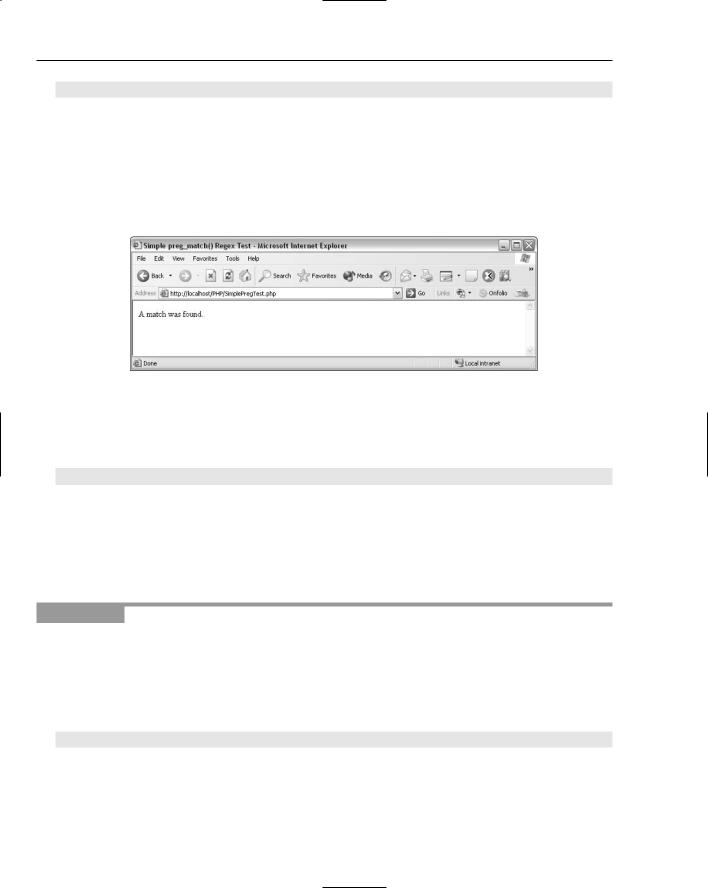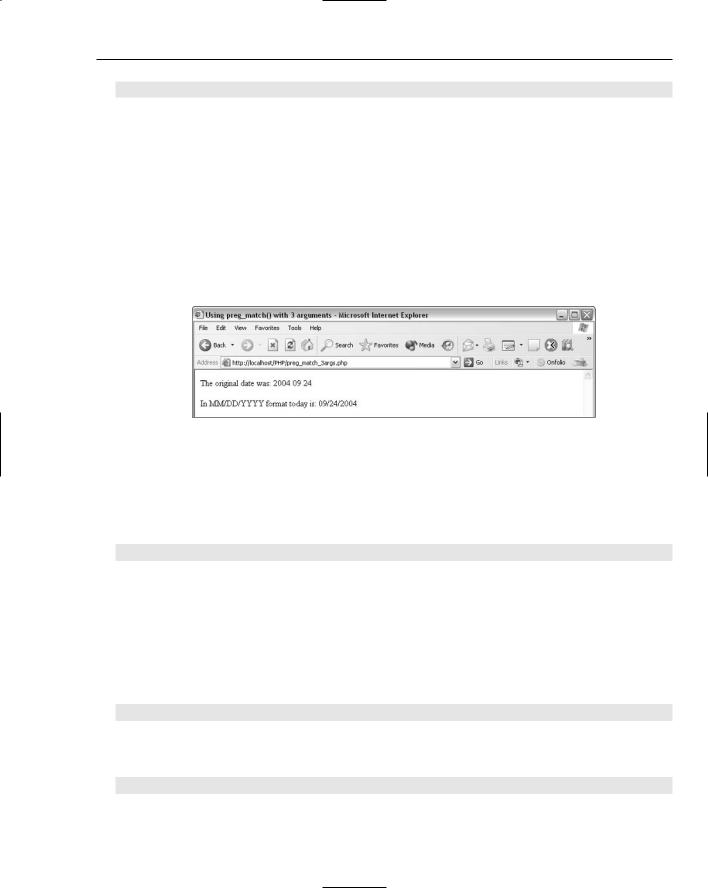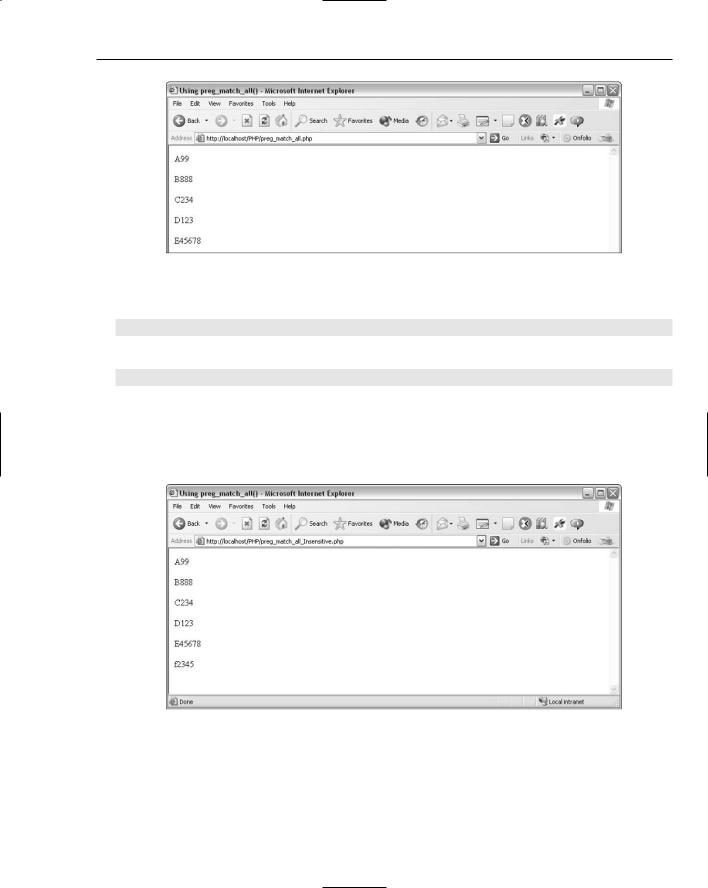
- •Introduction
- •Who This Book Is For
- •What This Book Covers
- •How This Book Is Structured
- •What You Need to Use This Book
- •Conventions
- •Source Code
- •Errata
- •p2p.wrox.com
- •What Are Regular Expressions?
- •What Can Regular Expressions Be Used For?
- •Finding Doubled Words
- •Checking Input from Web Forms
- •Changing Date Formats
- •Finding Incorrect Case
- •Adding Links to URLs
- •Regular Expressions You Already Use
- •Search and Replace in Word Processors
- •Directory Listings
- •Online Searching
- •Why Regular Expressions Seem Intimidating
- •Compact, Cryptic Syntax
- •Whitespace Can Significantly Alter the Meaning
- •No Standards Body
- •Differences between Implementations
- •Characters Change Meaning in Different Contexts
- •Regular Expressions Can Be Case Sensitive
- •Case-Sensitive and Case-Insensitive Matching
- •Case and Metacharacters
- •Continual Evolution in Techniques Supported
- •Multiple Solutions for a Single Problem
- •What You Want to Do with a Regular Expression
- •Replacing Text in Quantity
- •Regular Expression Tools
- •findstr
- •Microsoft Word
- •StarOffice Writer/OpenOffice.org Writer
- •Komodo Rx Package
- •PowerGrep
- •Microsoft Excel
- •JavaScript and JScript
- •VBScript
- •Visual Basic.NET
- •Java
- •Perl
- •MySQL
- •SQL Server 2000
- •W3C XML Schema
- •An Analytical Approach to Using Regular Expressions
- •Express and Document What You Want to Do in English
- •Consider the Regular Expression Options Available
- •Consider Sensitivity and Specificity
- •Create Appropriate Regular Expressions
- •Document All but Simple Regular Expressions
- •Document What You Expect the Regular Expression to Do
- •Document What You Want to Match
- •Test the Results of a Regular Expression
- •Matching Single Characters
- •Matching Sequences of Characters That Each Occur Once
- •Introducing Metacharacters
- •Matching Sequences of Different Characters
- •Matching Optional Characters
- •Matching Multiple Optional Characters
- •Other Cardinality Operators
- •The * Quantifier
- •The + Quantifier
- •The Curly-Brace Syntax
- •The {n} Syntax
- •The {n,m} Syntax
- •Exercises
- •Regular Expression Metacharacters
- •Thinking about Characters and Positions
- •The Period (.) Metacharacter
- •Matching Variably Structured Part Numbers
- •Matching a Literal Period
- •The \w Metacharacter
- •The \W Metacharacter
- •Digits and Nondigits
- •The \d Metacharacter
- •Canadian Postal Code Example
- •The \D Metacharacter
- •Alternatives to \d and \D
- •The \s Metacharacter
- •Handling Optional Whitespace
- •The \S Metacharacter
- •The \t Metacharacter
- •The \n Metacharacter
- •Escaped Characters
- •Finding the Backslash
- •Modifiers
- •Global Search
- •Case-Insensitive Search
- •Exercises
- •Introduction to Character Classes
- •Choice between Two Characters
- •Using Quantifiers with Character Classes
- •Using the \b Metacharacter in Character Classes
- •Selecting Literal Square Brackets
- •Using Ranges in Character Classes
- •Alphabetic Ranges
- •Use [A-z] With Care
- •Digit Ranges in Character Classes
- •Hexadecimal Numbers
- •IP Addresses
- •Reverse Ranges in Character Classes
- •A Potential Range Trap
- •Finding HTML Heading Elements
- •Metacharacter Meaning within Character Classes
- •The ^ metacharacter
- •How to Use the - Metacharacter
- •Negated Character Classes
- •Combining Positive and Negative Character Classes
- •POSIX Character Classes
- •The [:alnum:] Character Class
- •Exercises
- •String, Line, and Word Boundaries
- •The ^ Metacharacter
- •The ^ Metacharacter and Multiline Mode
- •The $ Metacharacter
- •The $ Metacharacter in Multiline Mode
- •Using the ^ and $ Metacharacters Together
- •Matching Blank Lines
- •Working with Dollar Amounts
- •Revisiting the IP Address Example
- •What Is a Word?
- •Identifying Word Boundaries
- •The \< Syntax
- •The \>Syntax
- •The \b Syntax
- •The \B Metacharacter
- •Less-Common Word-Boundary Metacharacters
- •Exercises
- •Grouping Using Parentheses
- •Parentheses and Quantifiers
- •Matching Literal Parentheses
- •U.S. Telephone Number Example
- •Alternation
- •Choosing among Multiple Options
- •Unexpected Alternation Behavior
- •Capturing Parentheses
- •Numbering of Captured Groups
- •Numbering When Using Nested Parentheses
- •Named Groups
- •Non-Capturing Parentheses
- •Back References
- •Exercises
- •Why You Need Lookahead and Lookbehind
- •The (? metacharacters
- •Lookahead
- •Positive Lookahead
- •Negative Lookahead
- •Positive Lookahead Examples
- •Positive Lookahead in the Same Document
- •Inserting an Apostrophe
- •Lookbehind
- •Positive Lookbehind
- •Negative Lookbehind
- •How to Match Positions
- •Adding Commas to Large Numbers
- •Exercises
- •What Are Sensitivity and Specificity?
- •Extreme Sensitivity, Awful Specificity
- •Email Addresses Example
- •Replacing Hyphens Example
- •The Sensitivity/Specificity Trade-Off
- •Sensitivity, Specificity, and Positional Characters
- •Sensitivity, Specificity, and Modes
- •Sensitivity, Specificity, and Lookahead and Lookbehind
- •How Much Should the Regular Expressions Do?
- •Abbreviations
- •Characters from Other Languages
- •Names
- •Sensitivity and How to Achieve It
- •Specificity and How to Maximize It
- •Exercises
- •Documenting Regular Expressions
- •Document the Problem Definition
- •Add Comments to Your Code
- •Making Use of Extended Mode
- •Know Your Data
- •Abbreviations
- •Proper Names
- •Incorrect Spelling
- •Creating Test Cases
- •Debugging Regular Expressions
- •Treacherous Whitespace
- •Backslashes Causing Problems
- •Considering Other Causes
- •The User Interface
- •Metacharacters Available
- •Quantifiers
- •The @ Quantifier
- •The {n,m} Syntax
- •Modes
- •Character Classes
- •Back References
- •Lookahead and Lookbehind
- •Lazy Matching versus Greedy Matching
- •Examples
- •Character Class Examples, Including Ranges
- •Whole Word Searches
- •Search-and-Replace Examples
- •Changing Name Structure Using Back References
- •Manipulating Dates
- •The Star Training Company Example
- •Regular Expressions in Visual Basic for Applications
- •Exercises
- •The User Interface
- •Metacharacters Available
- •Quantifiers
- •Modes
- •Character Classes
- •Alternation
- •Back References
- •Lookahead and Lookbehind
- •Search Example
- •Search-and-Replace Example
- •Online Chats
- •POSIX Character Classes
- •Matching Numeric Digits
- •Exercises
- •Introducing findstr
- •Finding Literal Text
- •Quantifiers
- •Character Classes
- •Command-Line Switch Examples
- •The /v Switch
- •The /a Switch
- •Single File Examples
- •Simple Character Class Example
- •Find Protocols Example
- •Multiple File Example
- •A Filelist Example
- •Exercises
- •The PowerGREP Interface
- •A Simple Find Example
- •The Replace Tab
- •The File Finder Tab
- •Syntax Coloring
- •Other Tabs
- •Numeric Digits and Alphabetic Characters
- •Quantifiers
- •Back References
- •Alternation
- •Line Position Metacharacters
- •Word-Boundary Metacharacters
- •Lookahead and Lookbehind
- •Longer Examples
- •Finding HTML Horizontal Rule Elements
- •Matching Time Example
- •Exercises
- •The Excel Find Interface
- •Escaping Wildcard Characters
- •Using Wildcards in Data Forms
- •Using Wildcards in Filters
- •Exercises
- •Using LIKE with Regular Expressions
- •The % Metacharacter
- •The _ Metacharacter
- •Character Classes
- •Negated Character Classes
- •Using Full-Text Search
- •Using The CONTAINS Predicate
- •Document Filters on Image Columns
- •Exercises
- •Using the _ and % Metacharacters
- •Testing Matching of Literals: _ and % Metacharacters
- •Using Positional Metacharacters
- •Using Character Classes
- •Quantifiers
- •Social Security Number Example
- •Exercises
- •The Interface to Metacharacters in Microsoft Access
- •Creating a Hard-Wired Query
- •Creating a Parameter Query
- •Using the ? Metacharacter
- •Using the * Metacharacter
- •Using the # Metacharacter
- •Using the # Character with Date/Time Data
- •Using Character Classes in Access
- •Exercises
- •The RegExp Object
- •Attributes of the RegExp Object
- •The Other Properties of the RegExp Object
- •The test() Method of the RegExp Object
- •The exec() Method of the RegExp Object
- •The String Object
- •Metacharacters in JavaScript and JScript
- •SSN Validation Example
- •Exercises
- •The RegExp Object and How to Use It
- •Quantifiers
- •Positional Metacharacters
- •Character Classes
- •Word Boundaries
- •Lookahead
- •Grouping and Nongrouping Parentheses
- •Exercises
- •The System.Text.RegularExpressions namespace
- •A Simple Visual Basic .NET Example
- •The Classes of System.Text.RegularExpressions
- •The Regex Object
- •Using the Match Object and Matches Collection
- •Using the Match.Success Property and Match.NextMatch Method
- •The GroupCollection and Group Classes
- •The CaptureCollection and Capture Class
- •The RegexOptions Enumeration
- •Case-Insensitive Matching: The IgnoreCase Option
- •Multiline Matching: The Effect on the ^ and $ Metacharacters
- •Right to Left Matching: The RightToLeft Option
- •Lookahead and Lookbehind
- •Exercises
- •An Introductory Example
- •The Classes of System.Text.RegularExpressions
- •The Regex Class
- •The Options Property of the Regex Class
- •Regex Class Methods
- •The CompileToAssembly() Method
- •The GetGroupNames() Method
- •The GetGroupNumbers() Method
- •GroupNumberFromName() and GroupNameFromNumber() Methods
- •The IsMatch() Method
- •The Match() Method
- •The Matches() Method
- •The Replace() Method
- •The Split() Method
- •Using the Static Methods of the Regex Class
- •The IsMatch() Method as a Static
- •The Match() Method as a Static
- •The Matches() Method as a Static
- •The Replace() Method as a Static
- •The Split() Method as a Static
- •The Match and Matches Classes
- •The Match Class
- •The GroupCollection and Group Classes
- •The RegexOptions Class
- •The IgnorePatternWhitespace Option
- •Metacharacters Supported in Visual C# .NET
- •Using Named Groups
- •Using Back References
- •Exercise
- •The ereg() Set of Functions
- •The ereg() Function
- •The ereg() Function with Three Arguments
- •The eregi() Function
- •The ereg_replace() Function
- •The eregi_replace() Function
- •The split() Function
- •The spliti() Function
- •The sql_regcase() Function
- •Perl Compatible Regular Expressions
- •Pattern Delimiters in PCRE
- •Escaping Pattern Delimiters
- •Matching Modifiers in PCRE
- •Using the preg_match() Function
- •Using the preg_match_all() Function
- •Using the preg_grep() Function
- •Using the preg_quote() Function
- •Using the preg_replace() Function
- •Using the preg_replace_callback() Function
- •Using the preg_split() Function
- •Supported Metacharacters with ereg()
- •Using POSIX Character Classes with PHP
- •Supported Metacharacters with PCRE
- •Positional Metacharacters
- •Character Classes in PHP
- •Documenting PHP Regular Expressions
- •Exercises
- •W3C XML Schema Basics
- •Tools for Using W3C XML Schema
- •Comparing XML Schema and DTDs
- •How Constraints Are Expressed in W3C XML Schema
- •W3C XML Schema Datatypes
- •Derivation by Restriction
- •Unicode and W3C XML Schema
- •Unicode Overview
- •Using Unicode Character Classes
- •Matching Decimal Numbers
- •Mixing Unicode Character Classes with Other Metacharacters
- •Unicode Character Blocks
- •Using Unicode Character Blocks
- •Metacharacters Supported in W3C XML Schema
- •Positional Metacharacters
- •Matching Numeric Digits
- •Alternation
- •Using the \w and \s Metacharacters
- •Escaping Metacharacters
- •Exercises
- •Introduction to the java.util.regex Package
- •Obtaining and Installing Java
- •The Pattern Class
- •Using the matches() Method Statically
- •Two Simple Java Examples
- •The Properties (Fields) of the Pattern Class
- •The CASE_INSENSITIVE Flag
- •Using the COMMENTS Flag
- •The DOTALL Flag
- •The MULTILINE Flag
- •The UNICODE_CASE Flag
- •The UNIX_LINES Flag
- •The Methods of the Pattern Class
- •The compile() Method
- •The flags() Method
- •The matcher() Method
- •The matches() Method
- •The pattern() Method
- •The split() Method
- •The Matcher Class
- •The appendReplacement() Method
- •The appendTail() Method
- •The end() Method
- •The find() Method
- •The group() Method
- •The groupCount() Method
- •The lookingAt() Method
- •The matches() Method
- •The pattern() Method
- •The replaceAll() Method
- •The replaceFirst() Method
- •The reset() Method
- •The start() Method
- •The PatternSyntaxException Class
- •Using the \d Metacharacter
- •Character Classes
- •The POSIX Character Classes in the java.util.regex Package
- •Unicode Character Classes and Character Blocks
- •Using Escaped Characters
- •Using Methods of the String Class
- •Using the matches() Method
- •Using the replaceFirst() Method
- •Using the replaceAll() Method
- •Using the split() Method
- •Exercises
- •Obtaining and Installing Perl
- •Creating a Simple Perl Program
- •Basics of Perl Regular Expression Usage
- •Using the m// Operator
- •Using Other Regular Expression Delimiters
- •Matching Using Variable Substitution
- •Using the s/// Operator
- •Using s/// with the Global Modifier
- •Using s/// with the Default Variable
- •Using the split Operator
- •Using Quantifiers in Perl
- •Using Positional Metacharacters
- •Captured Groups in Perl
- •Using Back References in Perl
- •Using Alternation
- •Using Character Classes in Perl
- •Using Lookahead
- •Using Lookbehind
- •Escaping Metacharacters
- •A Simple Perl Regex Tester
- •Exercises
- •Index

|
|
PHP and Regular Expressions |
|
|
|
|
|
|
|
Matching Modifier |
Description |
|
|
|
|
S |
Affects how a pattern is processed. If the S modifier is set, further |
|
|
analysis of how best to process the regular expression takes place. |
|
U |
The U modifier alters the “greediness” behavior of patterns. With U |
|
|
set, the default behavior becomes nongreedy (“lazy”). Matching |
|
|
becomes greedy with (? ... ). |
|
X |
Turns on Perl-incompatible behavior. |
|
e |
Applies to preg_replace() function only. |
|
|
|
Matching modifiers are written after the second of the paired or matched delimiters and immediately before the second of the paired double quote characters. So to match the pattern Hel case insensitively against the test string Hello world! using the preg_match() function, you would write the following:
preg_match(“/Hel/i”, “Hello world!”)
Several of these matching modifiers are used in examples later in the chapter.
Using the preg_match() Function
The preg_match() function attempts to match a pattern against a test string and is very similar to the ereg() function you used earlier. However, it is often faster than ereg() and so is to be preferred to ereg() when using versions of PHP that support PCRE functionality.
The preg_match() function can take two or three arguments. The first argument is a regular expression pattern. However, unlike ereg(), where you would write:
ereg(“Hel”, “Hello world!”);
to match the character sequence Hel in the string Hello world!, when you use the preg_match() function you must enclose the pattern in paired delimiters, such as paired forward slashes, inside the paired double quote characters. So when using preg_match(), you would write the following to match the character sequence Hel in Hello world!:
preg_match(“/Hel/”, Hello world!”);
The second argument is the test string. The optional third argument is a variable into which an array of groups will be returned, assuming that a match is found.
Try It Out |
A preg_match() Example |
1.Type the following code in a text editor:
<html>
<head>
<title>Simple preg_match() Regex Test</title> </head>
<body>
<?php
571

Chapter 23
if (preg_match(“/Hel/”, “Hello world!”)) echo “<p>A match was found.</p>” ?>
</body>
</html>
2.Save the code as C:\inetpub\wwwroot\PHP\SimplePregTest.php.
3.In Internet Explorer, enter the URL http://localhost/PHP/SimplePregTest.php, and inspect the displayed result, as shown in Figure 23-14. Because the pattern Hel is matched, the message A match was found. is displayed.
Figure 23-14
How It Works
The preg_match() function is used to produce a boolean value that can be tested in an if statement:
if (preg_match(“/Hel/”, “Hello world!”)) echo “<p>A match was found.</p>”
Notice that paired forward slashes are used as the delimiters for the regular expression pattern in the first argument of the preg_match() function:
The next example uses the preg_match() function with three arguments and manipulates the array elements specified in the third argument to the function. Array elements are numbered beginning at zero. Element [0] contains the whole match.
Try It Out |
Using the preg_match() Function with Groups |
1.Type the following code in a text editor:
<html>
<head>
<title>Using preg_match() with 3 arguments</title> </head>
<body>
<?php
$dateToday = gmdate(“Y m d”);
$myDate = preg_match(“/(\d{4})\s(\d{2}) (\d{2})/”, $dateToday, $dateComponents); if ($myDate)
{
572

PHP and Regular Expressions
echo “<p>The original date was: $dateToday</p>”; echo “<p>In MM/DD/YYYY format today is:
$dateComponents[2]/$dateComponents[3]/$dateComponents[1]</p>”;
}
?>
</body>
</html>
2.Save the code as C:\inetpub\wwwroot\PHP\preg_match_3args.php.
3.Type the URL http://localhost/PHP/preg_match_3args.php in Internet Explorer, and inspect the displayed results, as shown in Figure 23-15. The upper line of the Web page shows the original format of the date. The lower line shows the date expressed in MM/DD/YYYY format, with the new format being created using the $dateComponents array, which was created because $dateComponents was the third argument of the preg_match() function.
Figure 23-15
How It Works
The variable $dateToday is assigned a value returned from the gmdate() function. The arguments to the gmdate() function specify that the date is returned in YYYY MM DD format, with all values being expressed as numeric digits:
$dateToday = gmdate(“Y m d”);
The $myDate variable is assigned the value returned by the preg_match() function. Because there is a match for the pattern (\d{4})\s(\d{2}) (\d{2}) in the value of $dateToday, the $myDate variable holds the equivalent of the boolean value True. Notice that there is a space character between the second and third sets of paired parentheses.
The preg_match() function has three arguments, and the pattern in the first argument has groups created using parentheses. The $dateComponents variable is assigned array elements corresponding to each group created by the matched parentheses:
$myDate = preg_match(“/(\d{4})\s(\d{2}) (\d{2})/”, $dateToday, $dateComponents);
Because there is a match, the $myDate variable holds the value of True, so the statements contained in the if statement are executed:
if ($myDate)
573

Chapter 23
The original format of the date is displayed using the value of the $dateToday variable. The elements of the $dateComponents array are reordered to display the date in MM/DD/YYYY format:
{
echo “<p>The original date was: $dateToday</p>”; echo “<p>In MM/DD/YYYY format today is:
$dateComponents[2]/$dateComponents[3]/$dateComponents[1]</p>”;
}
The preg_match() function answers the question of whether or not a match is present. If you want to find and manipulate multiple matches (if they are present in the test string), you need to use the preg_match_all() function.
Using the preg_match_all() Function
The preg_match_all() function matches all character sequences in the test string that are matches for the specified regular expression.
Try It Out |
Using the preg_match_all() Function |
1.Type the following code in a text editor:
<html>
<head>
<title>Using preg_match_all()</title> </head>
<body>
<?php
$testString = “A99 B888 C234 D123 E45678 f2345”;
$myMatches = preg_match_all(“/[A-Z]\d{1,5}/”, $testString, $partNumbers); if ($myMatches)
{
for($counter=0; $counter < $myMatches; $counter++)
{
echo “<p>” . $partNumbers[0][$counter]. “</p>”;
}
}
?>
</body>
</html>
2.Save the code as C:\inetpub\wwwroot\PHP\preg_match_all.php.
3.In Internet Explorer, type the URL http://localhost/PHP/preg_match_all.php, and inspect the displayed results, as shown in Figure 23-16.
574

PHP and Regular Expressions
Figure 23-16
4.Edit the following line
$myMatches = preg_match_all(“/[A-Z]\d{1,5}/”, $testString, $partNumbers);
so that it matches case insensitively:
$myMatches = preg_match_all(“/[A-Z]\d{1,5}/i”, $testString, $partNumbers);
5.Save the amended code as C:\inetpub\wwwroot\PHP\preg_match_all_Insensitive.php.
6.Type the URL http://localhost/PHP/preg_match_all_Insensitive.php in Internet Explorer, and inspect the displayed results, as shown in Figure 23-17. Notice that there is an additional match displayed, f2345.
Figure 23-17
575
